Reynard’s Cave
Reynard’s Kitchen
Useful Information
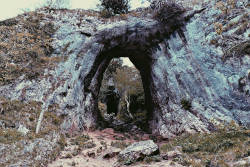
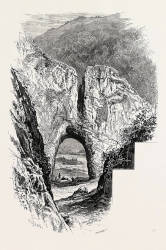
| Location: |
Dovedale Car Park, Dovedale, Ilam, Ashbourne DE6 2AY.
Half way between Thorpe and Milldale, accessible only by foot. From Stoke-on-Trent follow A52 towards Derby, from Derby towards Stoke-on-Trent. (53.069607, -1.784959) |
| Open: |
No restrictions. Dovedale Car Park: daily 9-17:30. [2022] |
| Fee: |
free. Dovedale Car Park: 4 h GBP 4, All Day GBP 6. [2022] |
| Classification: |
 Karst Cave Karst Cave
|
| Light: | bring torch |
| Dimension: | |
| Guided tours: | self guided |
| Photography: | allowed |
| Accessibility: | no |
| Bibliography: |
R. Smith (2015):
The Hoard in the Kitchen
in Archaeology and Conservation in Derbyshire, pp. 4-5.
issuu
|
| Address: | Dovedale Car Park, Dovedale, Ilam, Ashbourne DE6 2AY. |
| As far as we know this information was accurate when it was published (see years in brackets), but may have changed since then. Please check rates and details directly with the companies in question if you need more recent info. |
|
History
| 1959 | excavation by the City of Stoke Archaeological Society reveals Late Stone age flint tools. |
| 2014 | Reynard’s Cave Hoard discovered. |
Description
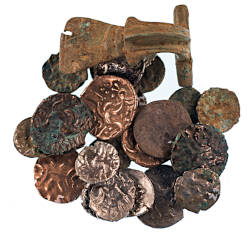
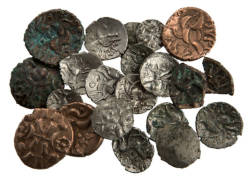
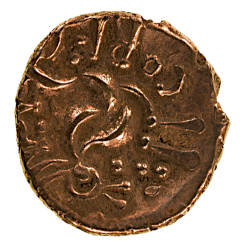
Reynard’s Cave or Reynard’s Kitchen is a small cave located high up on the eastern bank of the gorge of Dovedale in the Peak District. The cave is quite unspectacular, it’s just a single short passage, at least it is high enough to walk in upright. The floor is level, obviously the result of archaeological excavations. The cave is located halfway up the left slope of the valley. But while the cave itself is quite unspectacular, there were spectacular hindings made inside the cave, and even more interesting, the cave is located behind a huge natural bridge. It seems the cave was once much bigger, but the front was eroded and collapse partially. So there is now a huge portal, a natural bridge, followed by an unroofed cave section, and finally the small cave. The view from the ascent with the natural bridge and the cave behind, and the view from the cave entrance through the bridge down into the Dovedale valley.
The current situation is the result of the end of the last Ice Age, around 10,000 years ago. Huge amounts of glacial meltwater swelled the Dove into a powerful torrent. The valley was deepened, the drainage lowered, the cave was exposed. Since this time the cave was accessible and visited by humans, who they left traces in the cave. on the walls 17th century “witch” marks or apotropaic marks, which were used to ward off evil spirits, can be seen. The 1959 excavation by the City of Stoke Archaeological Society revealed Late Stone age flint tools and pottery shards.
In 2014 a hoard of late Iron Age and pre-Conquest Roman coins were found in the cave. The excavation was executed by archaeologists from the University of Leicester Archaeological Services (ULAS) in cooperation with the National Trust and the Defence Archaeology Group’s Operation Nightingale. Operation Nightingale are injured veterans who recuperate while assisting in archaeological excavations. This discovery is the most significant find of its kind in Britain. Such hoards were made by people who tried to hide valuables in times of danger. Probably they were killed by this danger and never returned to recover their valuables. And today they are even more valuable than then, because they allow archaeologists a glimpse into long gone times.
The hoard consists of 26 coins, 23 are of celtic origin, 3 are Roman coins. The Roman coins are exceptional, as they predate the Roman invasion of Britain in AD 43. In other words the were traded on the continent and found their way to Britain earlier. Also, there are rare Late Iron Age gold coins. And with the coins a Roman brooch was found. The findings from the cave can be seen in the Buxton Museum and Art Gallery.
This was actually not the only discovery of coins in the cave, there are vague reports in a 1926 guide book. It seems a small coin hoard was found there in 1925, but it was not documented and the coins are lost. Probably they will reappear in an inheritance some day.
According to legend the cave was used as a hideout by a local brigand named Reynard, hence the name. But there are also stories that the cave was used by foxes as a den, and the name was a result of the famous medieval allegory called Reynard the Fox. These stories about an anthropomorphic red fox and trickster figure started in the 12th century in France and were popular throughout the Late Middle Ages and all over Europe. Many of those stories were parodies of medieval literature or a satire of political and religious institutions, they were written by different authors. Later the stories were collected for 19th century children books. The fox even made it into a disney movie, the 1973 animation of Robin Hood, where Robin of Loxley is a cunning fox.
The cave is located in the Dovedale, halfway between Thorpe and Milldale, accessible only by foot. There are different possibilities, but the easiest would be a hike from the Dovedale Car Park near Ilam to Milldale. Other car parks at Thorpe may be cheaper or free, but the walk will be a little longer. Also, you should avoid good weather weekends during summer, as the area is quite popular. It’s a 5 km hike and there are numerous rock formations and caves along the trail. After Reynard’s Cave a section is called The Straits, where the footpath has been raised on wooden planks. A huge rock formation is called Lion’s Head Rock, then the dale opens for a while. The Pickering Tor and Ilam Rock are quite spectacular rock formations on opposite sides of the river. Ilam Rock has a small cave in its foot, and a little further there are two caves called Dove Holes.
- See also
 Search DuckDuckGo for "Reynard’s Cave"
Search DuckDuckGo for "Reynard’s Cave" Google Earth Placemark
Google Earth Placemark Reynard’s Cave (visited: 24-OCT-2022)
Reynard’s Cave (visited: 24-OCT-2022) Reynard’s Cave - Dovedale (visited: 25-OCT-2022)
Reynard’s Cave - Dovedale (visited: 25-OCT-2022) Reynard’s Kitchen Cave hoard – Late Iron Age and Roman coins (visited: 25-OCT-2022)
Reynard’s Kitchen Cave hoard – Late Iron Age and Roman coins (visited: 25-OCT-2022) Treasures in the Kitchen: Archaeological investigation of Reynard’s Kitchen, Dovedale, Derbyshire (visited: 25-OCT-2022)
Treasures in the Kitchen: Archaeological investigation of Reynard’s Kitchen, Dovedale, Derbyshire (visited: 25-OCT-2022) Find Spot record MDR15060 - Late Iron Age and Roman coin hoard, Reynard’s Kitchen Cave, Dovedale (visited: 25-OCT-2022)
Find Spot record MDR15060 - Late Iron Age and Roman coin hoard, Reynard’s Kitchen Cave, Dovedale (visited: 25-OCT-2022) The Dovedale Hoard (visited: 25-OCT-2022)
The Dovedale Hoard (visited: 25-OCT-2022)
 Index
Index Topics
Topics Hierarchical
Hierarchical Countries
Countries Maps
Maps